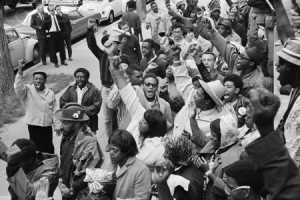From “Progressive Review” archives
VOD editor: Anthony Williams, who spoke at state Detroit review team meeting March 13, 2012, was Mayor of Washington, D.C. from 1999-2007. The state he left the city in is described below.
2008
DC FISCAL POLICY INSTITUTE – A detailed review of the District’s economy reveals a number of disturbing trends and shows that the city’s wide economic disparities are getting wider:
– Despite city-wide job growth, employment among African-American residents and those with no more than a high school diploma has been falling. The employment rate for these groups is at nearly the lowest level in 30 years.

Poor Peoples' 1968 March on Washington; Dr. Martin Luther King Jr.'s goals have yet to be achieved in that city.
– The gap between high-wage and low-wage workers in the District is at an all-time high. Wages have barely changed in 30 years for DC’s lowest-wage workers, after adjusting for inflation, while DC’s top earners have seen large earnings gains.
– Income inequality in the District is greater than in nearly every large U.S. city. DC’s rich-poor gap has widened over the past two decades. An analysis of 59 large U.S. cities by the Brookings Institution found that income inequality in DC was greater in 2006 than in every city except Atlanta and Tampa.
– Poverty in the District is at the highest level in nearly a decade. Since with the late 1990s, some 27,000 more DC residents have fallen into poverty.
These findings show that the District has two different economies: one represented by construction cranes, new jobs, and growing incomes – and another represented by people who work but earn very little, who are not moving into better jobs or higher wages, and who may not be working at all. The gleaming side of DC’s economy could continue to grow and prosper, but there is little evidence to suggest it would lead to any improvements for the thousands of residents who live on the other side.
Other stats:
– African-American residents are five times more likely than white residents to be unemployed. This gap was greater in 2006 than in any year since 1985.
– Employment among African-American adults has been falling since the late 1980s. The employment rate among black adults has even fallen during the city’s recent economic boom. Some 51 percent African-American adults worked in 2006, compared with 62 percent in 1988.
– Employment among residents with a high school diploma is at the lowest level in nearly 30 years. Just 51 percent of DC residents at this education level are working. In the late 1980s, by contrast, nearly two-thirds of residents with a high school diploma were employed.
– Real wages have barely changed for low-wage workers over 30 years. Hourly earnings for low-wage working DC residents rose just six percent between 1979 and 2006, after adjusting for inflation, compared with a 40 percent increase for high-wage workers.
– African-American median income is no higher than in 1980. . .
2007
56,000 FAMILIES NOT ENJOYING DC RENAISSANCE
DC EXAMINER – A record 56,047 families from the District of Columbia were on waiting lists for public housing and Section 8 vouchers in November – the latest month for which statistics were available. That’s up 7 percent from the same period in 2005, according to the D.C. Housing Authority. . . On any given day, about 300 families are waiting for a spot in D.C. Village, an emergency housing shelter under fire for overcrowding and infestations, among other problems. The shelter, which took in Tucker and Smith, has fewer than 70 beds under normal conditions. Altogether, the city has about 200 family shelter units – not enough to serve families in need. . .
The D.C. Fiscal Policy Institute recently estimated that rising rents alone caused a loss of 7,500 units with rents under $500 a month between 2000 and 2004. From 2003 to 2005, the median price of a Washington home shot up 67 percent, from $290,000 to $485,000. And more than 18,000 condos, many with big price tags, are under construction in the city.
AS OF 2004 the city had a waiting list of 43,000 families which means that despite the supposed renaissance, the list has shot up 30% in three years. The city had 50,000 residents of public and assisted housing with 9230 publicly assisted housing units, down from 11,473 in 1992.
Where did they go? Swallowed for the cause of a happier upscale city. Even the Housing Authority’s own reports imply that aiding gentrification is one of its responsibilities:
“DCHA received a $34.9 million grant award for the revitalization of Arthur Capper/Carrollsburg in October 2001. Arthur Capper/Carrollsburg, the Washington Navy Yard and the Southeast Federal Center, combine to form one of the largest urban redevelopment areas in the country, in one of the most outstanding locations. . . Arthur Capper and Carrollsburg Dwellings is a 23-acre 758-unit public housing complex located in Near Southeast. The properties are old and obsolete. The high concentration of low-income units combined with the barracks-style architecture of the developments have deterred any significant investment in the community.”
2006
ECONOMIC DEVELOPMENT VS. PUBLIC BENEFIT
COMMON DENOMINATOR – It’s time to change the lexicon for D.C. government-speak and replace the term “economic development” with “public benefit” when assessing the publicly funded projects under consideration by the city’s elected leaders. The new terminology might help some members of the D.C. City Council strip away the layers of obfuscation as they consider their votes in this election year. Voters understand the term “public benefit,” which means the general public gets something in return for the investment of their public dollars.
“Economic development” has been vague, at best, to describe what the public has received during the past few decades in return for its willingness to trust the promises made by the private development community to wrangle billions of dollars worth of tax breaks, bond financing and other public beneficence from elected officials.
Talk is cheap. Despite the public’s investment, the District’s high unemployment rate has remained nearly static during the “economic development” boom of the past decade and poverty has deepened. . .
Stadium proponents can’t seem to figure out how much it will cost to build the Taj Mahal – with the bottom line, minus financing costs, escalating about $200 million during the past year – and they want to build it on land that the city doesn’t yet own or control. . . There’s an important question of how D.C. residents will benefit tangibly from building a new stadium.
The Common Denominator asked Chief Financial Officer Natwar Gandhi’s office to answer that question in dollars and cents. The answer? There is no anticipated direct financial benefit in new city revenue, which has all been committed to paying off the stadium construction costs. The new city revenue committed to retiring the financing costs, and attributed directly to the stadium’s construction, includes estimated annual revenue of $14 million from a ballpark fee and $14 million from a utility tax, collected over 30 years from the business community. . .
A $28 million annual investment by the business community in the public schools, rather than a stadium, would generate real public benefits. The business community as a whole would reap benefits from a well-educated workforce, while a new stadium will benefit relatively few D.C. businesses.
http://www.thecommondenominator.com/010906_edit.html
Excerpts above from http://prorev.com/dcnews.htm#top





